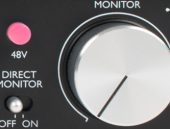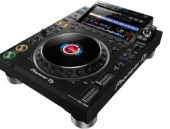-
When using effects in your DAW recording software, it’s important to think about the routing. Do you need to sequence the effects as inserts? Does the order matter? And what are the advantages of an AUX send? In this blog, we offer answers to these questions and explain just how to make your music sound just as fat as the last YouTube hit, simply by placing an effect where you usually wouldn’t place it in the effect chain. You might also be glad to know that a lot of what’s discussed here can also be applied to mixing desks.
-
Have you ever had to fight against a slight delay while recording, where you hear yourself back a fraction of a second after you’ve played or sung a note – a sort of annoying echo? It’s likely that you’re battling a known phenomenon called ‘latency’. This digital-based gremlin is caused by the long journey that the sound has to complete between your audio interface and DAW software and (usually) back again, along with the thinking power it takes your computer to record and play back at the same time. If you’re also applying some sweet effects to the sound, this can cause some really noticeable latency. In this blog, we explain how you can beat latency once and for all, or even just work around it.
-
If you’re a freelance musician, producer, or DJ, then you probably live a pretty unpredictable live where you’re suddenly travelling for months on end, or you just as suddenly have very little work and a lot of time at home. So, what can you do to make the very best of that in-between-time? In this blog, we offer 10 tips to help you stay productive at home.
-
If you have an audio interface of your own, or you’ve taken a look through our hefty selection of external audio interfaces, you’ve probably come across the term, ‘direct monitoring’. This mysterious function is actually pretty useful and can be enabled while you’re making recordings using DAW software. While recording, you can use direct monitoring to hear yourself using a connected set of headphones without being bothered by latency (so a delay between what you play or sing, and what you hear back as it’s being recorded). In this blog, I’ll explain how this works and what kind of direct monitoring is possible.
-
A fresh-faced top-shelf multiplayer like the Pioneer CDJ-3000 never enters the world alone. As such, it’s not just the hardware that you’re buying, it’s all the firmware updates and future additional functions that might be released that really get your mouth watering.
No responses | in: DJ -
Decisions, decisions, decisions… the Pioneer CDJ-3000 or the Denon SC6000? To be honest, it’s only you who can answer that question, but to help you out a little, we throw these two heavyweight mediaplayers into the ring and let them battle it out. Trained and developed by the most important DJ-brands of the moment, it’s anyone’s guess who’ll come out on top. As such, we kind of stepped back here and left it up to you to decide who wins out.
1 response | in: DJ -
Bax Music have been given the chance to take a little peak at the super-fresh Pioneer CDJ 3000. This shiny new, top-of-the-range Pioneer multiplayer is definitely going to be the next big thing, whether on a festival stage, in the club, or in the living rooms of Djs the world over. In this blog, we take a long look at the features that define this next-generation tabletop mediaplayer.
No responses | in: DJ -
You might know the deal. You’re at a wedding reception and an A4 sheet of paper is unceremoniously thrust into your hand. Ahhhhh … Auntie Pauline has taken it upon herself to re-write the words to ‘Your Song’ and you can only stand as witness as she very sweetly and very brutally murders one of the best love songs of all time. But, what if you wanted to offer the happy couple something even more unique? Something even more personal? Here, Guestblogger and singer-songwriter Kevin shares his tips for crafting a tailor-made wedding song.
-
The machine heads fitted to the headstock of an electric or acoustic guitar can come in many shapes and sizes: from closed oil-bed machine heads, to open-gear tuners, to the vintage tuners found blessing the heads of a Stratocaster or Telecaster, to the sunken tuning mechanics of a classical guitar. There is one flavour of machine head that is actually often demanded by guitarists: the locking tuner. Find out why right here.
-
Can a guitar or bass guitar that you buy online be set up and adjusted before it’s shipped off? This is a question that we get asked a lot. As such, we’ve put this little blog together to explain what actually goes into setting up a guitar or bass and why it’s not possible to – or actually understandable that we don’t – set up a brand new guitar before sending it out to you.
-
Effects: what’s out there and what do they actually do to sound? There’s a lot of ‘em, so if you’re already struggling to see the woods for the trees (or the other way around), then put the kettle on and make yourself comfy while we give you a glimpse of what’s possible. In this introductory blog, we’re poking our heads into the magical realm of reverb. Sprinkle it over your project to conjure atmosphere or completely submerge your track so it sounds like it’s calling to you from another world.
-
If you’re nothing but a humble mortal, it’s best not to even touch the mastering process. While this is a wide belief, is it actually a myth? The potential offered by most DAWs and a host of plug-ins certainly makes a DIY mastering job much easier, so why not give it a go? These 5 tips will not only ease your first few unsteady mastering steps but give you better results.
Sign up for the Bax Music Blog Update!
Just fill in your email address and we'll drop a fresh instalment of blogs in your mailbox every month so you never have to miss out again.
Subjects
About Bax Music
Bax Music is your go-to online music store in the UK with more than 48,000 bits of gear and accessories in stock. More than 1,000 brands and a 26,000m2 warehouse packed with musical instruments, DJ and studio gear, headphones, speakers and lighting. Ordered before 10 PM? Receive delivery in 2 - 4 business days.
Wanted: Guest Blogger!
Become a Video Reviewer!
Recent Posts
 NAMM 2025 – Top 10 Releases30 January 2025
NAMM 2025 – Top 10 Releases30 January 2025 Picking Out the Right PA System for a Wedding29 January 2025
Picking Out the Right PA System for a Wedding29 January 2025 The History and Features of Hard Rock and Heavy Metal29 January 2025
The History and Features of Hard Rock and Heavy Metal29 January 2025 How to Start a Band29 January 2025
How to Start a Band29 January 2025 How to Be a Wedding Singer28 January 2025
How to Be a Wedding Singer28 January 2025 Does a Good Musician Make a Good Band Mate?28 January 2025
Does a Good Musician Make a Good Band Mate?28 January 2025 Hybrid Drums: The Best of Both Worlds28 January 2025
Hybrid Drums: The Best of Both Worlds28 January 2025 How Do You Tune a Mixer, Speakers and Amplifier to Each Other?28 January 2025
How Do You Tune a Mixer, Speakers and Amplifier to Each Other?28 January 2025 Relic’ing a Guitar or Bass: How and Why23 January 2025
Relic’ing a Guitar or Bass: How and Why23 January 2025 A 5-Step Guide to Clean Recordings for Budding Mixing Engineers23 January 2025
A 5-Step Guide to Clean Recordings for Budding Mixing Engineers23 January 2025
Recent Comments
- Marnix | Bax Music on Special Chords: Rare but Useful
- Fungk on Headless Guitars: The Pros & Cons
- Johnny B. on Special Chords: Rare but Useful
- Black Beauty 16 on The Snare Buzzes When I Hit the Tom: Can I Fix it?
- Stefan | Bax Music on Phantom Power: This is What You Need to Know
- Marnix | Bax Music on How To Connect A Record Player To An Amplifier Or Pair Of Speakers
- Lily on How To Connect A Record Player To An Amplifier Or Pair Of Speakers












